As the pace of healthcare quickens and the number of brands multiplies, it’s patients, not medical businesses, who decide which brands live and which ones die.
An overabundance of look-alike medical brands and me-too services are forcing patients to search for something, anything, to help them separate the winners from the clutter.
Today’s patients seek out brands that create experiences; that intrigue them in a sensorial, emotional, and creative way.
My promise to you is that by the end of reading this article, you’ll have the components of a brand strategy so you can pivot your medical business to a higher level.
A level where profitability is predictable, success is inevitable, and a lasting healthcare brand that empowers its patients.
This article also covers:
What is healthcare branding?
- Patient cognitive bias towards certain brands
- The danger of looking like everyone else in healthcare
- The difference between healthcare marketing and branding
- The unmatched advantages of branding your medical business
- The 5 stages of healthcare branding strategy
- How to measure your branding efforts
- Example of branding in other healthcare fields
Let’s start.
What is healthcare branding?
Healthcare branding is the management of all components that make a healthcare brand for which patients believe there’s no substitute.
So how do you define a brand?
A brand is not your logo, it’s not your ads or marketing campaign. It is not your visual identity, graphics, or business collateral. And It is not the “sum of all impressions from your customer”.
A brand is your customer’s feeling towards your brand. It is what makes you unique in the eyes of people. It is a feeling because our judgments and buying decisions are based on trust, not rationality.
As much as we like to say “I base my buying decision on logic”, We don’t. Buying decisions are made by our limbic system . The part of the brain that is responsible for decision-making.
Trust creation is a fundamental goal of brand design….Trust is the ultimate shortcut to a buying decision and the bedrock of modern branding.
― Marty Neumeier
How to know if you have an established healthcare brand?
#~1) A brand needs to be different. If a brand is not differentiated, it is not a brand. It is a “me too” service or a product. If you claim to have a brand it needs to be unique in a way that sets you radically apart, adds value, and enhances the experience to your patient.
# QUICK TEST
If you want to put your medical business to the test, Finish the following positioning statement exercise. A seemingly easy but surprisingly hard to finish sentence:
Our Medical Brand Is the only [Category] That [Differentatior].
Template: Our ____Is The Only ____That ____.
Example: Our practice is The Only Cosmetic Service That puts its patient’s confidence a #1 Priority.
#~2) The brand has substance. A brand without purpose is a soulless brand. If your healthcare brand is not purpose-driven people won’t join it. In addition, it should be heading towards a concrete objective or a vision. The word vision/mission is tossed around a lot but much of the so-called “mission/values/vision” are treated as decoration rather than a compass for the brand to follow. And rarely are maintained.
#~3) The brand cultivates a community around it. Your brand does not exist in a vacuum. It needs to be supported by its stakeholders and customers. Your brand will be the ecosystem for the whole team AND the patients to thrive. It will be a playground for increased productivity, innovation, and profitability.
#~4) Your brand needs to reflect its audience values. Your brand should mirror what your patient/audience believes. If your brand does not offer a flattering reflection of its customer’s core values, it will not gain their loyalty. If I’m an overly cautious person and value safety, my go-to hospital will be healthier™ , the risk-free hospital. If I’m into enhancing my lifestyle quality, I’ll sign up for The Joint Chiropractic membership. If I want to avoid the dental horror show, my favorite dental practice will be Odentia, the painless dental experience.
#~5) Your healthcare brand should carry human attitudes. Gone are the times where brands communicate their robotic offering and wait for patients to come. “We offer the best care service” Yeah? So does everyone. People now value communication that is infused with humanistic attributes. Your brand should claim a communication voice that is unique to your business. We’ll lay down examples of this approach in the next few sections.
#~6) Your brand is aesthetically meaningful. In an information-rich and time-poor age, aesthetics are the best communication language for your medical business. Great medical brands are not tied with the “blue color + red heart” symbol design. Their aesthetics convey meaning to their patients and sets them apart from the “lookalike” visuals.
If you can check all of the 6 points above, I suggest you do not waste your time reading this article. You are already ahead.
If not, stick around. I’ll provide you with a complete roadmap to revamp your whole practice into a dazzling healthcare brand.
Patient cognitive bias and why we favor a medical brand over another
In his book, Start With The Why, Simon Sinek explains why some brands are more successful than others. He proposes that for brands to have a cult-like loyalty and lead their market, they need to articulate their “why” and be vocal about it.
By “why” he meant your reason for being or your purpose. Why do you do what you do (besides making money) and why would anyone care? It seems an easy task but it is a surprisingly hard feat to accomplish. Most brands know what they do, some know how they do it, but few who know why they do what they do.
The logic for why communicating your purpose is a competitive edge lies in our biological structure. We value meaningful messages more than a robotic, bland value offering. And we make our decision based on how much trust signals we got from said messages.
To illustrate, I’ll use two pitches for a dental practice, one with a why message (or a purposeful message) and the other with a what message (a simple value offering).
#~First (WHAT MESSAGE):
We’re Confidental™, we provide the highest oral care services for our patients at an affordable price. Enjoy a brighter smile!
It states who they are, and what they do. Good. It also explains how this benefits patients (affordable prices/brighter smile). Let’s see how this will look when your “why” is well articulated.
#~SECOND (WHY MESSAGE):
What good is a smile if you’re nervous about it? Our practice was founded to help patients lead a stress-free lifestyle. The more confident you are, the less stressed your life is. There are many ways to fight anxiety; one is to be confident in your dental appearance. That’s where we come in. We make you confident in your smile.
Being vocal about the Why in the second pitch does one thing that gains you a competitive edge. It influences preference-based judgments about your medical business.
When you use a purposeful message, your communication is perceived by the limbic system, the part of the brain that is responsible for emotions and decision-making.
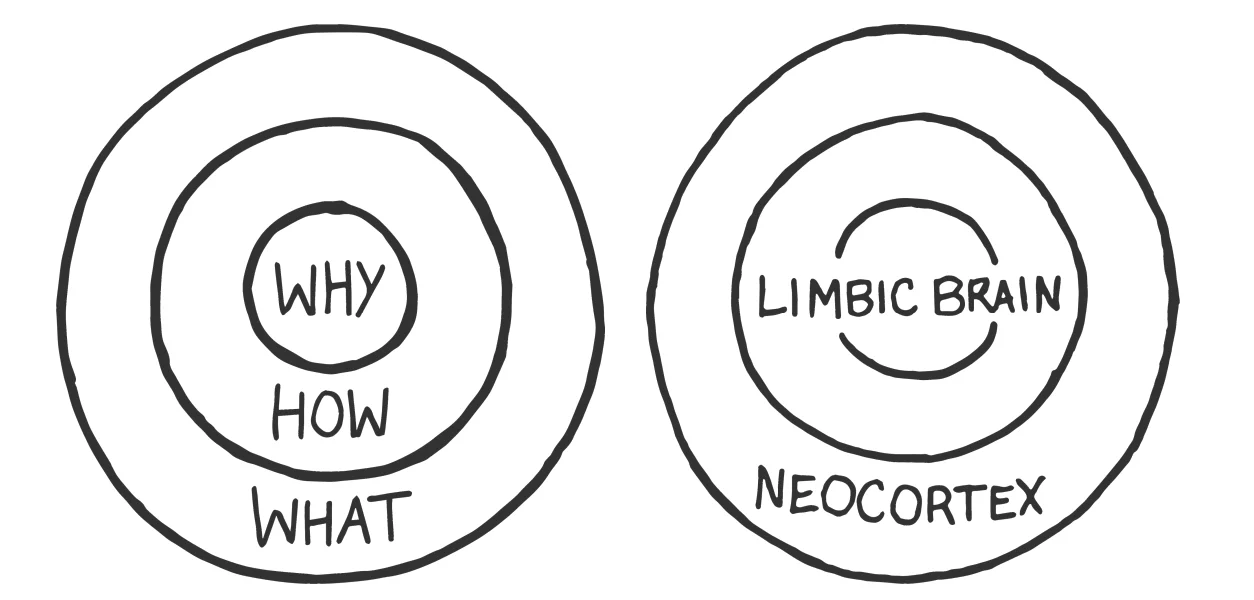
When your medical brand is purpose-driven, it attracts with meaningful messages rather than pushes with uninspiring marketing.
Being clear on your why create a bias towards your practice and patient will favor your brand no matter who the alternatives are.
# TAKEAWAY
“If I can trust the maker, I can buy it now and worry about it later. The degree of trust I feel towards the service, rather than an assessment of its features and benefits, will determine whether I’ll buy this service or that service”.
The danger of not branding your healthcare business
With the never-ending rise of competition, if you do not possess a competition-proof healthcare brand, your business will be submerged in the sea of sameness.
We’ll go through some of the issues that if left untreated can risk your business’s long-term success.
#1) The looming shadow of healthcare commoditization
With the Affordable Care Act (ACA) and the shift from a Fee-for-service to a Fee-for-value, primary healthcare is increasingly becoming commoditized.
We’re seeing companies provide direct-to-consumer services that can be ordered online and fulfilled from a single remote location. An example of that is the rise of DIY dentistry, why go to a board-certified orthodontist when you can get braces in the mail?
Roman also offers online doctors who you can see right in your home, diagnose and prescribe you with prescriptions that get delivered right to your address.
The insurance and corporate entities are encouraging and promoting this trend. This is disheartening to solo-practitioners and medical business owners.
Big Pharma also suffers from the cutthroat competition by the generic “me too” drugs that flood the market once the patent expires for their branded counterparts.
The need for differentiation is acute.
#2) The rapid rise of competition in healthcare
The increased competition in the healthcare industry gives patients a wide range of choices to pick from. Patients are pickier than ever with high expectations for your care quality and lower prices demands. Resulting in a price-cutting race to the bottom. A race no one wishes to win.
The same medical facilities offering the same care services and competing for the same patient.
Some medical businesses try to “avoid” this risk by offering better equipment or advanced tech stack. But this differentiation is not radical. It is a mere attempt to gain a foothold. To be different means to claim competitive attributes that are unique to you and irreplaceable to your patients.
#3) Grabbing short-term gains while incurring the long-term losses.
Most patient acquisition “strategies” target the wrong aspect of healthcare marketing . The advertising campaign, social media marketing, referrals, or word-of-mouth, all focus on one thing: acquiring.
The catch here is that acquiring a new customer is 5 to 25 times more expensive than retaining an existing one. Meaning medical businesses are focusing on the more expensive ways to generate cash flow. Instead, the main focus should be rerouted to retaining.
However, the issue with the current patient retaining “strategies” like “leverage personalization”, “communication with passion”… is that they are mere techniques and not cohesive enough. Retaining a patient should be planned, strategized, and measured for the long run. We’ll see how brand strategy offers such capabilities in the next few sections.
#4) Dwindled productivity and the rise of internal silos
When your staff starts feeling like “a cog in the machine”; when processes overshadow purpose; when decisions seem disconnected or when patients are uncollaborative, you experienced the gradual emergence of functional silos.
When people work at cross-purpose, they start losing the high sense of mission and everyone starts pulling in a different direction. Creating an inconsistent patient experience and hurting the work productivity of your practice.
Your stakeholders need to gather around a concrete mission. A mission that gives meaning to the role they play. It is your job as the leader to supercharge your business with mission-driven strategies. And I’m not talking about the hidden mission statement that no one reads or the “message from our CEO” video.
Having a mission-driven business is not about crafting the same sounding statements and expecting that to be the catalyst for a successful healthcare brand.
Being mission-driven requires gaining external and internal buy-ins to your medical brand. It requires strategic planning and maintaining your core values year after year.
The difference between healthcare branding and marketing.
Marketing is inviting somebody on a date; Branding is the reason they say yes.
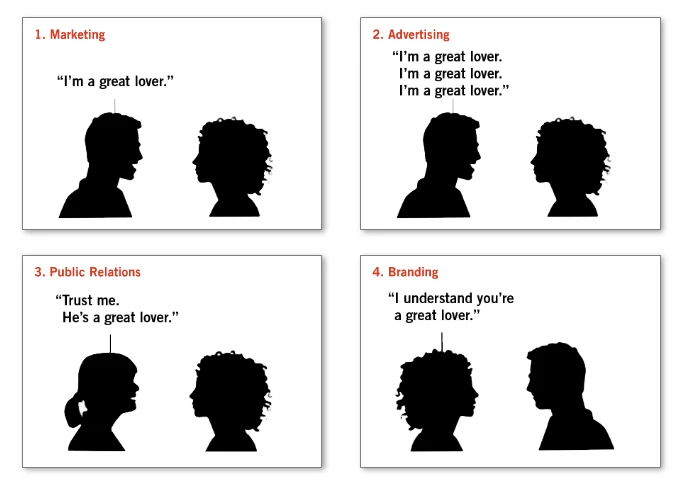
Marketing without branding is a mere tactic that comes with an expiration date.
If your marketing efforts are not directed by the branding strategy and do not communicate your brand attributes, it will never cultivate your brand and build loyalty.
Marketing should be focused on reaching and communicating the brand’s values to your audience.
While branding is cultivating these attributes and directing your marketing channels so your messages and philosophies are communicated without distortion.
Branding is hyper-focused on building loyalty, trust, and empowering your patients and stakeholders.
The unmatched advantages of branding your healthcare business
Before getting into the processes of a brand strategy, let’s explore what benefits and perks branding can offer your business.
#1) Branding cuts through the “me too” medical brands
With the overabundance of imitative care services, branding creates an unbreachable wall against the competition. By branding your medical business, you create new reasons for why patients should favor your practice over the rest of the pack.
Since branding renders the competition irrelevant, it works as a vaccine against market commoditization. It singles your brand out of the “me too” brands. Your medical business will drill its mark in the minds of your patients.
#2) Increasing profitability and gaining higher market shares
An established healthcare brand often claims the dominant position in their respective fields, with market shares of 50% or higher.
They also tend to command the highest price premiums- up to 40% more than generic services.
This is because patients know that your brand has no substitute. It is the only brand that can fulfill their care needs in its unique way.
When your medical business is not cutting down prices for the sake of competing or “staying alive”, it can flourish and thrive.
#3) Profitable and seamless M&A transactions
There are several benefits of a brand strategy when it comes to M&A transactions (mergers and acquisitions, the transactions in which the ownership of a business is transferred or consolidated with other entities).
We’ll explore how branding can facilitate an M&A.
#~First, for target firms in an M&A transaction, Brand Equity (the perceived worth of a brand) is a significant role when acquirers evaluate target firms. To secure a higher ROI deal from an M&A, your brand is the most valuable asset to benefit from.
#~Second, for acquirers, having brand guidelines works as a “decisional filter” against target firms candidates.
You need to target firms that will empower your brand portfolio. And to do this, you should ask questions like Will this hospital/practice solidify our position in the market? Will it purify or defocus our mission? Do their values and our purpose match or do they contradict each other?
To find a clear answer to questions like these, you need to let your brand’s core attributes guide your decisions.
#~Third, the failure rate of M&A transactions is said to be between 7090% and that a poorly conceived or executed M&A destroyed more than $200 billion in shareholder value in 20 years.
Some of the major reasons for this are manifold:
- Clash of personalities
- When merging happens between healthcare businesses, clashes of values are bound to happen. This leads to internal conflict between key personnel and major disagreement hindering business processes.
- Cultural shock
- When disregarding the corporate culture, mergers suffer the inevitable decrease in operational efficiency. If internal stakeholders are not on board with the new culture, a decrease in productivity is predictable.
- Poor communication
- Often, in an M&A transaction, the target firm’s employees are wary of job losses and the acquirer’s staff adapt the “conqueror mentality”. This leads to unvoiced opinions and an uncollaborative environment for the whole team.
This is where brand strategy comes into play.
It unifies stakeholders under one umbrella. By using a communication framework and building a brand culture, you can mitigate the risk of a failed merger.
#4) Innovation and productivity are predictable, not accidental
Your medical business’s performance starts with the internal dynamics of your brand. If your whole team is unified around one purpose and vision, it will also attract patients and engage them in a deep and meaningful relationship that transcends the traditional marketing goals of brand preference and loyalty.
Brand culture is the culture that a company cultivates in order to powerfully and consistently deliver its brand to the market. It’s how people work together to bring the brand alive for customers.
― Mark Di Somma
When your medical business has a brand culture of its own, staff are encouraged, invested and operational efficiency will soar up. Work becomes more thrilling and meaningful. Conversely, if the brand lacks culture, it disengages staff leading to a decreased productivity and your business values fizzle out before reaching your patients.
# STATS
According to recent research, 94% of executives believe that having a workplace culture is key to a thriving business.
#5) Creates “brand preference” and skyrockets patient retention
Unlike other means of patient acquisition, branding pulls. It aims to entice patients to favor your business, NOT push them into it.
It creates relationships between your brand and the patient, forming a firm rope that links your patients and the brand. Since branding is a creative and a stirring way to attract patients, it shapes what we call “brand preference”.
Brand preference is a cognitive judgment a patient makes regarding your brand. It measures to which extent purchasing decisions are made based on the attachment to your brand rather than the price, convenience, or regardless of the alternatives.
In addition, Creating strong brand preferences boosts patient retention. When your patients perceive your practice to be the only brand that speaks to them on an emotional level, their attachment and loyalty to the brand get deeper.
“Can you measure brand preference”? Yes. We’ll go into brand measurement in a few moments.
The 5 processes of branding strategies
In this section, we’ll go into the 5 stages of a branding strategy and unfold how each stage creates an established brand for your medical business.
Stage ~1) Brand DNA
In this part of the process, we build the DNA of your brand, the bedrock, and the values that will be the building blocks of your business.
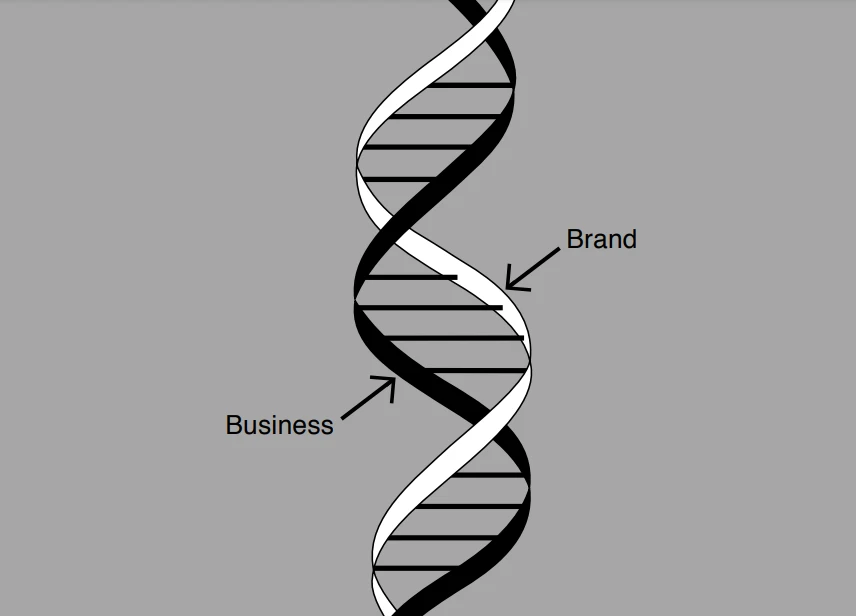
#1) Brand Essence
To build meaningful relationships, your brand must carry a purpose behind it. This is why digging deep and extracting the essence of the brand is critical. In this phase, we uncover the story and the “why” behind your medical business and how it impacts your audience.
#2) Future Brand
Without a concrete vision for your brand, it can never navigate future-storms or thrill and challenge your stakeholders. The Future Brand phase focuses on crafting a visionary path for your brand that will act as the brand’s true north.
#3) Brand Pillars
In this phase, we extract the guideline principles that direct your brand. These philosophies and attributes will be communicated later to your audience in a novel manner. Each decision will be vetted against your Brand Pillars, they will regulate any future commitments.
Stage ~2) Brand Positioning
Positioning does not seek to beat the competition. Instead, it aims to make the competition irrelevant
― Renée Mauborgne
Positioning is where your care service stands in relation to others offering similar services.
The positioning stage is all about focusing your brand on a specific audience and specific value offering. It’s about building perception and infusing uniqueness into your brand.
To illustrate, I’ll use an example:
Healthier™ , An Orlando Based hospital, is positioned as the safest hospital in town. Although it offers the same service lines, it’s focused on safety and welfare.
Patients visit Healthier because it’s the risk-free choice. In their ads, visual identity, communication, everything emphasizes safety.
Here’s Healthier positioning statement:

Another positioning example comes from Odontia, a dental practice based in Pasadena, CA. Odentia is positioned as the pain-free dental experience. They understand how patients are reluctant to visit the dentists because of the looming fear of a bad dental experience.
Odentia is the only dentistry service that puts painless dental experience as its #1 Priority.
Odentia Positioning Statement:
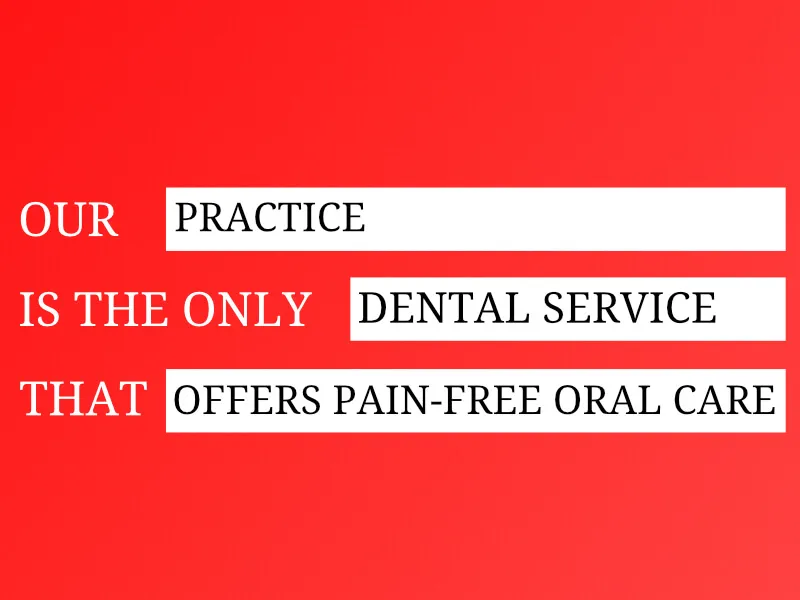
Developing a differentiator or and a positioning for your medical business is the first key to break through the noise. The positioning of your brand must be prominent throughout all contact points your patient has with your brand, thus creating a consistent and unique experience.
Stage ~3) Brand Persona
This stage is about infusing humanistic attributes into your brand’s communications. To make deeper connections, your messaging needs a dash of personality.
We’ll develop a unique voice and a persona for your brand so it resonates perfectly with your target audience.
This stage consists of 2 Phases, Brand Archetype, Brand Voice.
#1) Brand Archetype
As we are all different, our desires are different. When we consider that certain behaviors or personalities increase certain desires, we can understand why some personalities appeal to us more than others.
An archetype is a typical character that represents universal patterns of human nature.
They are the personification of our behaviors and provide a roadmap that enables you to more accurately appeal to a given audience with a specific personality.
According to Psychologist Carl Jung , there are twelve archetypes:
The Innocent, Everyman, Hero, Outlaw, Explorer, Creator, Ruler, Magician, Lover, Caregiver, Jester, and Sage.
Each archetype represents a collection of desires that make up their values.
For example:
The ruler archetype is driven by the desire to control, lead, and power.
CEOs and other C-suite executives fall into the ruler archetype.
On the other hand, an archetype like Caregiver is driven by a desire to care for others, compassion, and safety.
In this case, Mothers-to-be can represent the caregiver archetype.
This stage will identify your ideal audience personality, then align your brand with the archetype that would most appeal to their desire.
The trick here is to align your brand as tightly as possible to a single archetype to allow your brand personality to feel all the more familiar to your audience and to communicate with the consistency and humanity of a real person.
Let’s say your target audience is mothers-to-be and your hospital helps them deliver babies. (A caregiver archetype)
Your brand should also embody the caregiver archetype, meaning, the communication will be soft-spoken, reassuring, and caring.
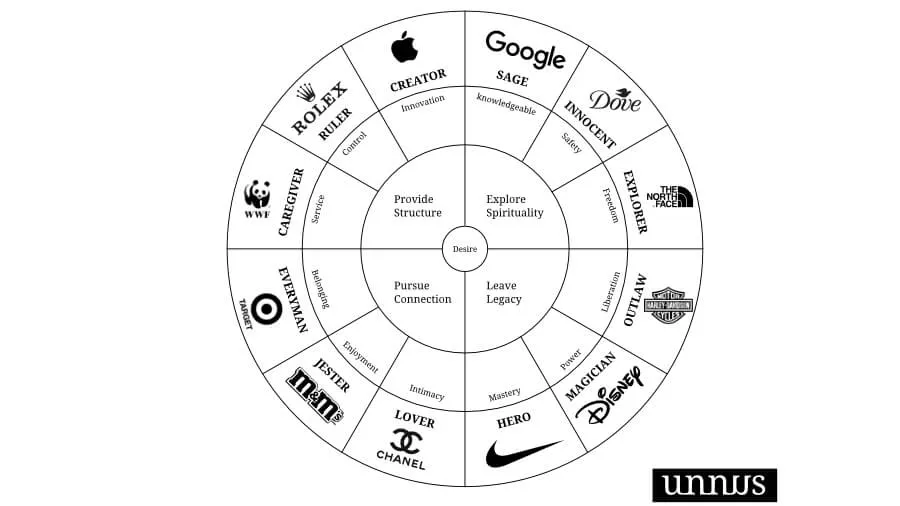
#2) Brand Voice
If your brand could talk, in what manner would it speak? This is exactly the aim of this phase. To define the personality of the target audience and THEN to craft a voice or a manner of speak that fits your brand archetype.
Brand voice is the tone and language used when communicating your brand’s message, ads, marketing, website copy, or when talking with your patient.
The tone of voice should reflect the brand’s personality and should be appealing to your target customer. Is your brand’s voice formal or playful? Serious or authoritative? Your communication should be consistent throughout all contact points your patient has with your brand.
Here’s a non-medical example of a brand’s voice.
A tongue-in-cheek billboard advert for The Economist in 1990 that sympathizes with their target audience: CEOs and company executives.
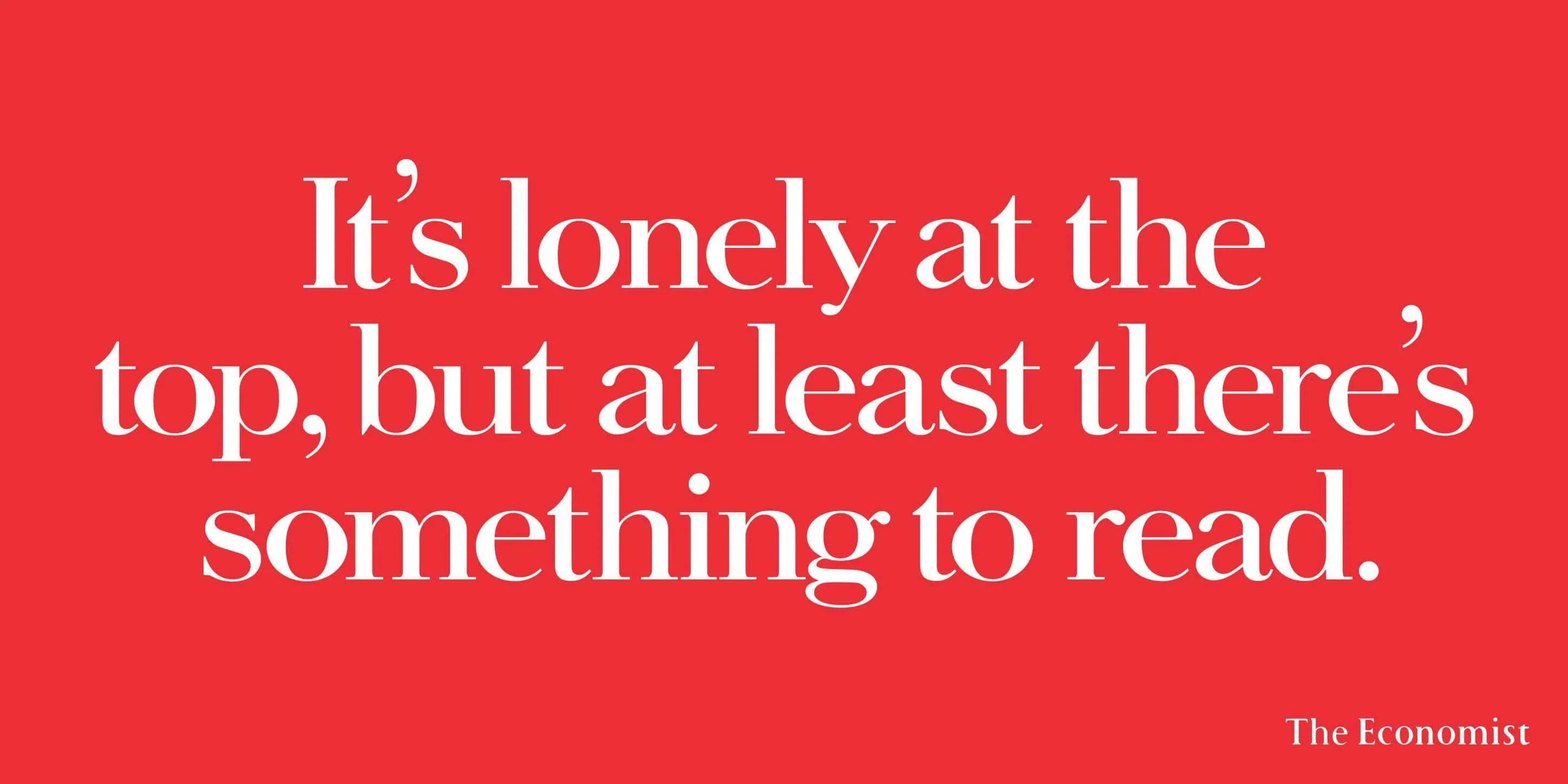
Strip away the huge salary and the executive jet, and you find much solitary misery. Even chief executives are human.
The economist’s tone of voice and the message connects deeply with their audience, creating stronger bonds and loyalty for the brand.
Another example from Arnold Palmer Hospital:

When defining your voice, brands should know who their talking to.
That’s what Arnold Palmer Hospital does throughout its marketing channels.
It’s talking to worried moms and dads.
Their voice is reassuring and realistic.
Stage ~4) Brand Communication Framework
All the above strategies will amount to very little if they are not well communicated to your audience. So, how do you go about sharing your positioning, personality, and philosophies to the market? This stage is the portal from which you’re going to send your messages to your patients.
In the Brand Communication Framework process, we utilize techniques such as Storytelling, Main Narrative, and Secondary Messaging.
We’ll dissect your positioning in the market to secondary messages and form small sets of stories out of them.
These stories will then be distributed through all of your communication channels. Form of social media, press, website, blog articles, case studies, and ad campaigns.

This way you can—asynchronously—feed your target audience your message and position in the market.
This framework will act as a compass for every touchpoint your audience has with your brand. Its goal is to create consistency across all contact points while telling stories about the brand.
Stage ~5) Brand Art Direction
No one gets a second impression. And so does your brand’s visuals.
In healthcare, visuals are predictable. “blue/red/green” + “heart/plus or a teeth/smile symbol”. By far, this is the most underutilized aspect of branding in the industry.
Your aesthetics are the first element your would-be patients encounter with your brand. So visuals should work as an “optical communication” for first impressions, conveying meaning, and your positioning to your patients.
Your visual identity should inform and complement your brand’s values while at the same time differentiating your medical business from the competition.
When done right, great aesthetics have the power to turn a commodity into a premium brand. And in this stage of the branding process, we start by visualizing the brand’s values and market position based on its internal branding.
Here’s what most companies fail to accomplish: they use the same color scheme, same design pattern, same overall aesthetics, and call that “consistent visual identity”.
You can be consistent, but consistently meaningless. Your visual identity is as good as the meaning behind it.
If your visuals do not reflect your brand’s or the product’s promise to your patient, it has not succeeded to do its mission.
The good news is, your visuals will be based on your brand’s positioning, philosophy, and purpose. The design aspect of the brand will mirror its values and what it stands for. Hence solidifying its market position and perception.
**One Medical Visual Identity **


How to measure branding success?
In the business world, often the focus is on yearly revenue or sales. Not only that, but marketers, in order to measure their marketing efforts, they need to project the sales each quarter.
And to accomplish they use a model called purchase funnel.
This model tracks sales by tracking customers as they move from awareness (being aware of your business) to interest to consideration to intent to evaluation and, finally, to purchase your service.

This model is only helpful if:
Your main goal is to project revenue in the short term
- Patients move toward their purchase in predictable stages
- Current revenues are more important than brand- building
- Acquiring customers is more important than keeping them or;
- You have no use for non-customers.
There are a lot of ifs here, most of which no longer pans out.
Instead of stuffing patients into funnels and squeezing the profit out of them, healthcare brands should encourage, empower, and delight their patients so they can build the brand.
This is not to say that monthly or quarterly revenues are not important. Just that monthly and quarterly revenues are more sizable, more profitable, and more dependable when you focus on long term relationships instead of short-term revenues.
Enters: The Brand Ladder
Because the objective of branding is to nurture and build relationships, it puts the emphasis where it belongs—on the customer (your patient).
The Brand Ladder model aims to measure the success of the branding effort by tracking the patient attachment and loyalty to your brand. It offers a clear metric as to how your medical business is doing at each level.
Each rung of the ladder represents a satisfactory state of your patient with your brand. From patient satisfaction to delight, to engagement, and finally to empowerment. The object is to get as many customers as possible up the ladder to the top.

Here’s how it works:
#~First, The bottom rung represents patient satisfaction. This is where trust begins. The patient has tried your care service and found it to be as advertised.
While satisfaction is a good sign, studies have shown that satisfaction alone is not a reliable predictor of repurchase behavior or patient loyalty.
#~Second, The next rung up is patient delight. Here’s where trust really catches fire. If you can surprise your patient with something more than baseline satisfaction, you’ll spark the kind of emotion that leads to loyalty.
This is the realm of great patient experience because delight is the leading cause of a patient’s “willingness to recommend.”
#~Third, One level higher is patient engagement. When a patient is truly engaged with a brand, he or she enrolls in the tribe. With membership comes increasing loyalty, escalating repurchase habits, and an emotional attachment that goes far beyond patronage.
This is where the brand becomes a building block in the patient’s identity, success, well-being, and even fulfillment.
#~Fourth, On the top rung is patient empowerment. This is the level at which patients incorporate your brand into the deepest part of their lives. They may depend on it for emotional support, social status, personal growth, or even business success.
They would no more switch to another brand than swap their right leg for a wooden peg. If you suddenly pulled your brand out from under them, they would collapse in a heap.
Empowered patients will move heaven and earth to ensure your success, happily attracting others to the tribe with their magnetic sense of commitment.
Measuring Branding with the Brand Commitment Scale (BCS)
The Brand Commitment Scale is an easy-to-use survey that yields a single number from 20–100. This score represents your overall progress up the brand ladder, where empowerment is given four times the weight of satisfaction.
If conducted annually, the BCS can highlight your gains (or losses), suggesting where you need more investment. It can also let you compare the scores at each rung of the ladder, and for each of the eight questions.

The power of this survey lies in its simplicity. All it takes is a service like SurveyMonkey and a little of your patient’s time. A sample of 1,000 surveys should be enough for most medical businesses to get a useful reading.
Examples of branding in the healthcare industry
Healthcare is a vast industry. So to provide you with a wider set of examples of how these branding efforts play under different circumstances, I will lay down a list of articles on how branding will look like in some of the popular medical fields.
Hospital branding
When your hospital staff takes refuge in functional silos instead of a collaborative ecosystem; when you face the jagged transition to value-based care; when the market dynamics changes before you adapt; when patient retention dwindles; or when your hospital is swimming in a sameness-sea of “me too” hospitals, it’s no surprise half of the current health systems will vanish.
So, how will you cut through these hurdles?
Well, this is what I’ll share with you in this article.
In this article, you’ll discover:
What is a hospital brand?
- What is a hospital brand strategy?
- Perks and advantages of branding your hospital
- How can a brand strategy take your hospital to a new level?
- Case study of an established hospital brand
- Pivoting your hospital during this pandemic
To read about hospital branding click here
Dental branding
In this article, I’ll share with you what makes a charismatic dental brand, and how by branding your practice you can achieve patient loyalty to your practice.
I’ll also share with you the 3 deadly sins dental practices make when trying to build an authentic brand.
This article covers:
- What is dental branding? What it is not, and other myths.
- What makes up a drab, bland, and dull dental brand.
- What makes up a charismatic dental brand.
- Advantages of having a charismatic dental brand.
- Quick techniques to know if your practice is charismatic
To read about dental branding click here
Pharma Branding
In this article, we’ll discuss fatal but easy-to-turn-a-blind-to issues in the pharmaceutical industry and how branding can solve these problems.
By the end of this article, you’ll have a clear understanding of
- Threats that Big Pharma is facing
- What is branding in the pharmaceutical industry?
- The unmatched advantage of branding; And
- The 5 stages of developing a pharmaceutical brand strategy
To read about pharma branding click here
Healthcare mission statements development + Examples
In this article, we’ll go into how to develop a mission statement for your medical business that stands out.
You’ll craft a mission statement that is unique, memorable, and—authentic.
Furthermore, we’ll see the practical use cases of a mission statement and how it will benefit your practice.
This article covers:
- What is a mission statement in healthcare?
- Why most medical businesses fail to develop an authentic mission statement
- The practical importance of a mission statement
- What you need to do BEFORE forming a mission statement
- How to develop a mission statement
- Examples of mission statements in healthcare (Hospitals, dentists, chiropractic, etc..)
- What to do and what NOT to do with your mission statement.
To read about healthcare mission statements click here
The truth about healthcare branding
Healthcare branding brings new ways to reach patients. A way that is focused on building relationships and long-term success for your medical business.
Building a brand can be the competitive edge that singles you out of the sea of “sameness”. It is a future-proof strategy for leaders to supercharge their business with.


